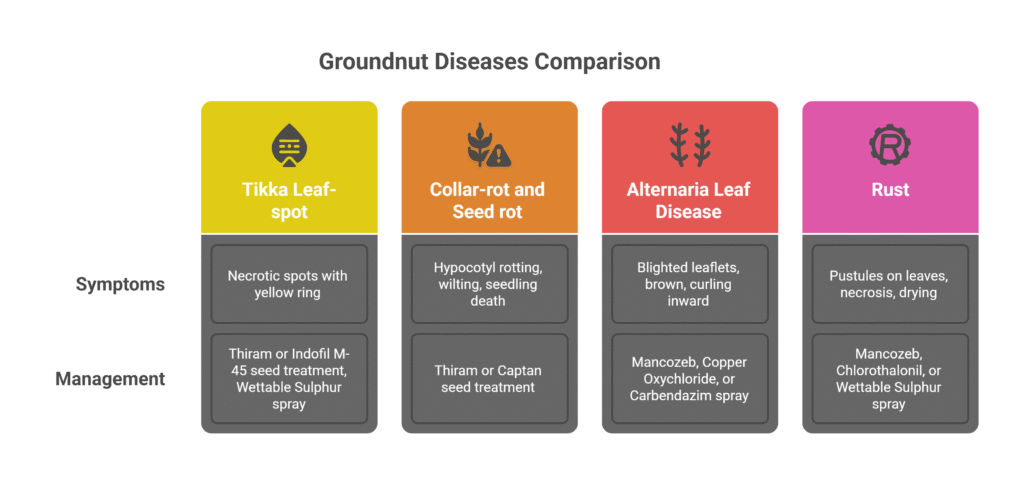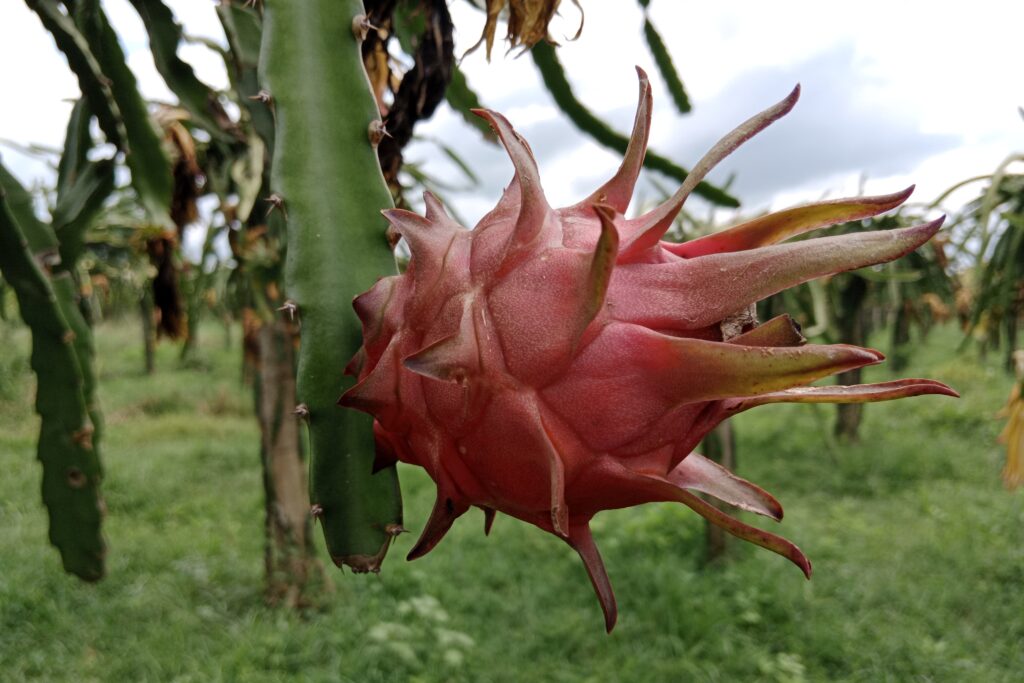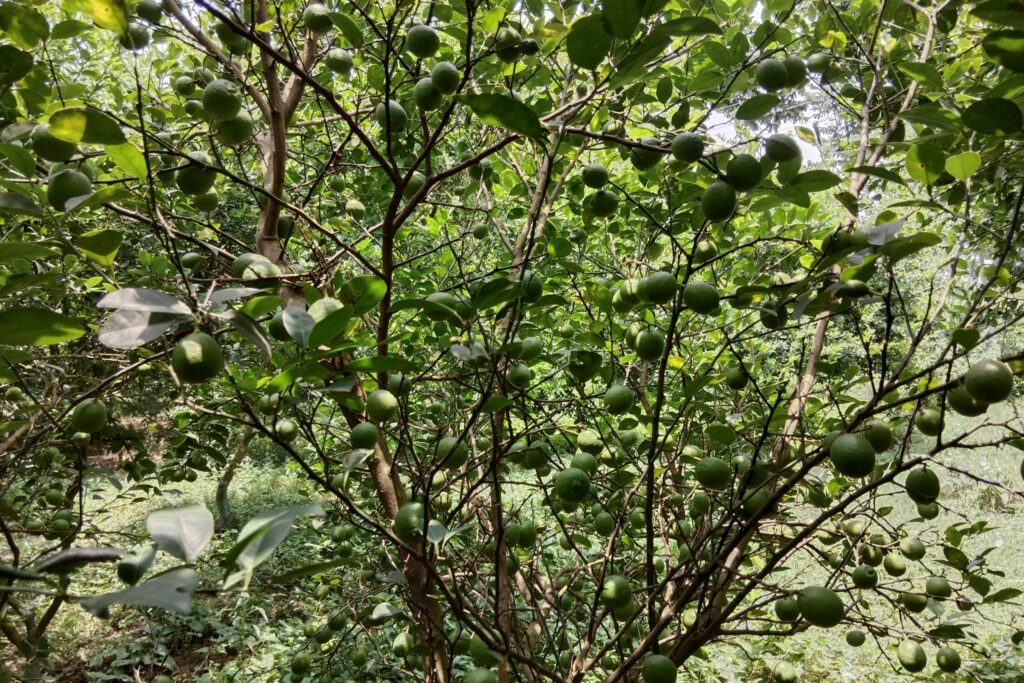Groundnut Farming
An in-depth analysis of groundnut farming profit per acre reveals compelling financial outcomes for cultivators. Based on a total income of NRs 150,000 generated from an estimated yield of 1,500 kg (marketed at NRs 100/kg) against a comprehensive investment of NRs 40,000 covering land preparation, seeds, labor, inputs, and harvesting, the net profit reaches NRs 110,000 per acre.

This substantial profitability is further quantified through key financial metrics: a 73.33% profit margin (calculated as 110,000150,000×100150,000110,000×100), indicating high revenue efficiency, and an exceptional 275% Return on Investment (ROI) (derived from 110,00040,000×10040,000110,000×100), demonstrating that every rupee invested yields NRs 2.75 in profit.
These figures underscore groundnut farming’s potential as a high-return venture, though they remain subject to variables such as yield stability, market fluctuations, and cost management strategies.
Land Preparation
Groundnut farming requires thorough land preparation to ensure good seed-to-soil contact and proper drainage. The land should be plowed to a depth of 15-20 cm and leveled to facilitate uniform planting. This process helps eliminate weeds, improve soil aeration, and promote root penetration. It is essential to break large clouds and create a fine tilth for effective groundnut growth.
Soil Type
Groundnuts thrive in deep, well-drained sandy loam, sandy clay loam, or light loamy soils with a pH range of 6.5 to 7 and high fertility, as these conditions allow for easy pod penetration and minimize the risk of waterlogging, which can cause root rot; conversely, heavy clay soils or saline-alkaline soils should be avoided as they hinder pod formation and overall plant development.
Climatic Requirements
Groundnuts, being warm-season crops, thrive in tropical or subtropical climates with optimal growth occurring at temperatures between 20°C and 30°C, as temperature is a major environmental factor determining their development rate. Climatic conditions, particularly temperature and rainfall, significantly influence production, requiring adequate and well-distributed rainfall (600 to 1500 mm annually), especially during critical stages such as flowering, pegging, and pod formation, to achieve maximum yield and seed quality.
Major Cultivars
Groundnut varieties are classified into three types: early-maturing (90-100 days), medium-maturing (100-120 days), and late-maturing (120-130 days). Common cultivars include:
| Maturity Type | Variety | Days to Maturity | Remarks |
| Early-Maturing (90–110 Days) | TMV 2 | 90–100 days | Suitable for short growing seasons. |
| TAG 24 | 90–100 days | Suitable for short growing seasons. | |
| JL 24 | 90–100 days | Suitable for short growing seasons. | |
| AL 882 | Early maturing | Dwarf variety, yields 5.4 qtl/acre. | |
| Medium-Maturing (111–120 Days) | M-522 | 115 | High shelling percentage (68%). |
| ICGS1 | 112 | Spanish bunch type, disease resistant. | |
| M-197 | 118–120 | Semi-spreading type, high oil content. | |
| K6 | 100–120 days | Popular for balanced growth and yield. | |
| K9 | 100–120 days | Popular for balanced growth and yield. | |
| Late-Maturing (121 Days and Above | M548 | 123 | Grown in sandy areas, oil content: 52.4%. |
| SG 99 | 124 | Disease-resistant, shelling: 66%. | |
| M-335 | 125 | Recommended for irrigated conditions. | |
| M-145 | 125 | High protein content, semi-growing type. | |
| C-501 | 125–130 | Semi-spreading, suited for loamy soils. | |
| SG-84 | 120–130 | Light brown seeds, good oil content. | |
| PG-1 | 130 | Recommended for rain-fed conditions. | |
| VRI2 | 120–130 days | Requires longer growing seasons. | |
| ICGS 44 | 120–130 days | Requires longer growing seasons. | |
| Moongphali No. 13 | 125–135 | Vigorous growth, bold seeds, high yield. |
Seed Rate
For optimal groundnut cultivation, a seed rate of 35-40 kg per acre is recommended to ensure adequate plant population, leading to better growth, higher yields, and efficient utilization of resources.
Planting
Planting Season
Groundnuts are typically sown during the rainy season (kharif), from June to July, with early sowing strongly recommended, as delays can significantly reduce yield.

Spacing
To ensure adequate sunshine exposure and ventilation, maintain a 30 cm gap between rows and 15 cm between plants within each row.
Planting Method
Groundnut seeds are sown directly into the soil using line sowing at a depth of about 5 cm, either behind the plough or with the help of a dibbler or seed planter. Treating seeds with fungicides like Thiram before sowing is essential to protect them from soil-borne diseases and ensure healthy crop establishment.
Number of Plants per Acre
Approximately 89,933 plants per acre are recommended, depending on the above-mentioned spacing.
Irrigation
Groundnuts usually need three to five irrigations throughout the course of their crop cycle; the precise number depends on soil moisture and rainfall. For the best plant growth and pod production, irrigation is crucial during the flowering, pegging, and pod development periods. Although too much moisture can cause waterlogging and raise the danger of diseases like stem rot, which can drastically lower crop production and quality, caution must be taken to prevent over-irrigation.
Groundnut Fertilizer and Manure
Fertilizer application for groundnut should be based on soil testing results to ensure balanced nutrient management. The appropriate fertilizer doses for groundnut cultivation are detailed in the table below, considering factors like soil nutrient status, crop growth stages, and seasonal requirements.
| Application Stage | Material | Rate/acre | Method & Key Details |
| 1. Pre-Planting (Soil Prep) | Farmyard Manure (FYM) / Compost | 4-5 tonnes | Apply once every 2-3 seasons. Incorporate into the soil. |
| 2. Basal Application (At Sowing) | Nitrogen (N) | 8 kg (Kharif) / 10 kg (Rabi) | Best source: Ammonium Sulfate (provides Sulfur). |
| Phosphorus (P₂O₅) | 16-24 kg | Apply as Single Superphosphate (SSP) or Triple Superphosphate (TSP). | |
| Potassium (K₂O) | 24 kg (Kharif) / 30 kg (Rabi) | ||
| 3. Flowering Stage | Gypsum (Calcium) | 50 kg | Soil Application ONLY. Apply to the soil surface. Avoid foliage contact (causes scorch). Lightly incorporate (inter-cultivate/weed) after application. Prevents Blossom End Rot & aids pod/seed development. |
| Borax + Planofix | 500g Borax + 50ml Planofix per acre | Apply together as a foliar spray on leaves. Increase pod filling, yield & quality. | |
| 4. Pod Formation Stage | Nitrogen (N) – Top Dressing | 8 kg (Rabi season only) | Apply to the soil. Best source: Ammonium Sulfate. |
Weed Control
Weed management is essential in groundnut farming, especially during the first 6–8 weeks, as weeds compete for essential resources like nutrients, water, and light. Weeding can be carried out using mechanical tools, hand-pulling, or pre-emergence herbicides such as Pendimethalin (1 liter per acre) or Fluchoralin (600 ml per acre).
Two rounds of hoeing are advised: the first three weeks after sowing and the second three weeks later. Intercultural activities should stop once the pegs begin penetrating the soil to avoid damaging the plants. A single hand weeding is recommended between 36–40 days after planting for better weed control.
During this time, earthing up should also be performed, either alongside late hand weeding or following herbicide application. This vital practice, carried out within 40–45 days after sowing, facilitates peg penetration into the soil and boosts pod development, enhancing overall yield.
Pest and Disease Management
Common Pests
a) White grub
Adult white grub beetles emerge in June-July with the first rains, feeding on nearby trees like ber, guava, and grapes at night. They lay eggs in the soil, and the larvae damage groundnut roots. To manage them, plough fields twice in May-June to expose beetles, avoid delayed sowing, and treat seeds with Chlorpyriphos 20EC (@ 12.5 ml/kg kernels). For beetle control, spray carbaryl (@ 900 g/100 liters water), repeating after rainfall until mid-July. Apply Phorate (@ 4 kg/acre) or Carbofuran (@ 13 kg/acre) to the soil at or before sowing.
b) Hairy Caterpillar
Hairy caterpillars, reddish-brown with black bands and hairs, defoliate crops and reduce yields. Use 3–4 light traps after rains and destroy egg masses. Prevent larval migration by digging trenches (30 cm deep, 25 cm wide) around infested fields. In the evening, distribute poison bait made of 10 kg rice bran, 1 kg jaggery, and 1 liter Quinalphos. For young larvae, dust Carbaryl or Quinalphos (300 ml/acre), and for grown caterpillars, spray Dichlorvos 100 EC (200 ml in 200 liters of water/acre).
c) Groundnut leaf minor
Groundnut leaf miner larvae start by creating small purple spots on leaflets and later weave the leaflets together, feeding inside the folds. Severe infestations result in a “burnt” appearance across the field. Control measures include installing 5 light traps per acre and spraying Dimethoate 30EC (300 ml/acre), Malathion 50EC (400 ml/acre), or Methyl Demeton 25% EC (200 ml/acre).
d) Termites
Termites damage groundnuts by hollowing out the tap root and stem, causing plant wilting, and boring into pods to destroy seeds. To prevent termite infestation, use well-decomposed cow dung and avoid delaying the harvest. Treat seeds with Profenofos at 6.5 ml/kg of seed to minimize damage, and in endemic areas, drench Profenofos at 2 liters/acre into the soil before sowing.
e) Pod borer
Pod borer infestation in groundnuts is identified by holes in young plants that are often plugged with excreta. The nymphs are white in their early stages and gradually turn brown as they mature. Effective control measures include applying Malathion 5D at 10 kg per acre or Carbofuran 3% CG at 13 kg per acre. These treatments should be incorporated into the soil approximately 40 days before sowing in fields with a history of infestation to prevent damage and ensure healthy crop establishment.
Common Diseases
a). Tikka or Cercospora Leaf-spot
Tikka or Cercospora Leaf-spot appears as necrotic circular spots surrounded by a light-yellow ring on the upper side of leaves. To manage the disease, start with healthy, unblemished seed selection and treat seeds before sowing with Thiram (75%) at 5 g/kg or Indofil M-45 (75%) at 3 g/kg of kernels.
For effective control, spray Wettable Sulphur 50 WP at 500–750 g in 200–300 liters of water per acre, applying 3–4 sprays at fortnightly intervals starting from the first week of August. Alternatively, for irrigated crops, spray Carbendazim (Bavistin/Derosal/Agrozim 50 WP) at 500 g in 200 liters of water per acre, with three sprays at fortnightly intervals starting when the crop is 40 days old.

b). Collar-rot and Seed rot
Diseases caused by Aspergillus niger significantly impact groundnut cultivation by leading to the rotting of the hypocotyl region, which often results in wilting and eventual death of seedlings. These diseases can severely affect plant establishment and overall yield if not managed properly.
A critical step in controlling these diseases is seed treatment, which helps prevent fungal infections and ensures healthy germination. Seeds should be treated with fungicides such as Thiram or Captan at a dosage of 3 g per kilogram of seed before sowing. This practice creates a protective barrier against Aspergillus niger, reducing the likelihood of infection and promoting robust seedling growth.
c). Alternaria Leaf Disease
Alternaria leaf disease is marked by blighting of the apical portions of leaflets, which turn light to dark brown, eventually curling inward and becoming brittle. In advanced stages, lesions caused by Alternaria alternata appear as small, chlorotic, water-soaked spots that spread across the leaf surface. To manage the disease, foliar applications of fungicides such as Mancozeb (3 g/L), Copper Oxychloride (3 g/L), or Carbendazim (3 g/L) of water are recommended at the first sign of infestation.
d). Rust
Rust disease begins with the appearance of pustules on the lower surface of leaves and may spread to all aerial parts of the plant except flowers and pegs. Severely infected leaves become necrotic, dry out, yet remain attached to the plant. Upon noticing infestation, spray Mancozeb (400 g/acre), Chlorothalonil (400 g/acre), or Wettable Sulphur (1000 g/acre). If needed, repeat the spray after 15 days.
Harvesting
Groundnuts are ready for harvest when leaves turn yellow and the pods mature, typically 90-130 days after planting, depending on the variety. Carefully uproot plants to avoid pod damage. Dry pods under the sun for 2-3 days before shelling and storing. Proper post-harvest handling ensures high-quality produce.
Cost of Investment per Acre of Groundnut Farming
| S.N. | Category | Cost (NRs) |
| 1 | Land Preparation (plowing) | 10,000 |
| 2 | Seed per acre | 2,000 |
| 3 | Seed sowing | 3,000 |
| 4 | Fertilizers and Manure | 5,000 |
| 5 | Irrigation | 6,000 |
| 6 | Weed Control (pre/post-emergence) | 3,000 |
| 7 | Pest & Disease Control | 3,000 |
| 8 | Harvesting | 5,000 |
| 9 | Miscellaneous Costs | 3,000 |
| Total Cost | 40,000 |
Income from groundnut farming per acre
| Particulars | Estimated Yield (kg) | Market Price (NRs/kg) | Total Income (NRs) |
| Groundnut yield | 1,500 | 100 | 150,000 |
Analysis of groundnut farming profit per acre
The profit analysis per acre for groundnut farming shows a total income of NRs 150,000 against a total investment cost of NRs 40,000. This results in a net profit of NRs 110,000 per acre (calculated as Profit = Income – Cost = 150,000 – 40,000). This translates to a profit margin of 73.33% (derived from [Profit / Income] × 100 = [110,000 / 150,000] × 100) and an exceptionally high Return on Investment (ROI) of 275% (calculated as [Profit / Cost] × 100 = [110,000 / 40,000] × 100). These metrics demonstrate strong profitability for the venture.


